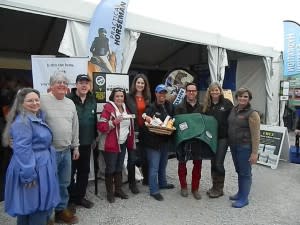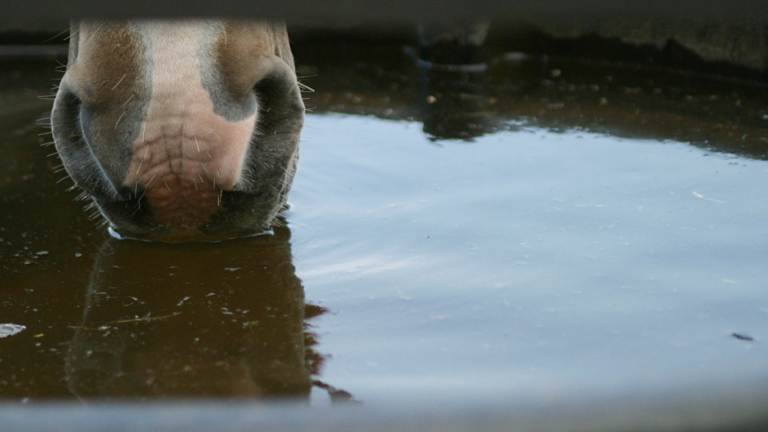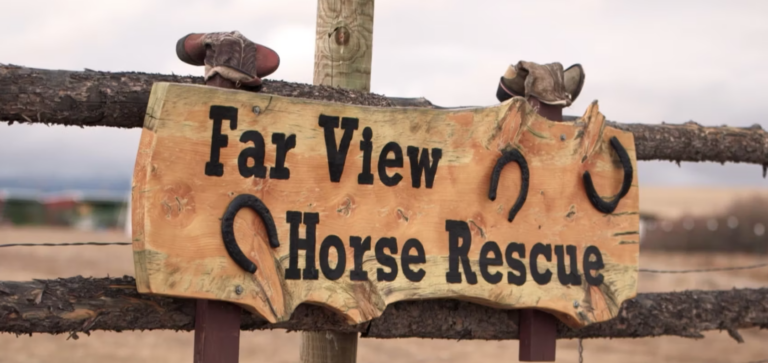Recently, a friend told me she was having trouble finding a trainer to start her 9-year-old horse under saddle. One refused to take on the horse without giving any reason, then another told her that horses were no longer trainable after they turned 9. This surprised us both: Neither of us considers a 9-year-old horse to be “old.”

I am well aware of the prejudice against training older horses who’ve never been ridden or those still considered “green.” However, as founder and president of Bluebonnet Equine Humane Society in Waco, Texas, I have had the opportunity to work with such horses, and I can assure you that there’s no particular age at which it’s too late to start a horse. They’re all individuals—some young horses can be quite a handful, while some older ones settle right into their new jobs.
In fact, I’ve found that most older horses are more than capable of learning new skills or unlearning bad habits. Plus, they offer some important advantages that younger horses do not:
? Unless they were abused or totally neglected, older horses—even the untrained ones—often have a “been there, done that” attitude that enables them to stay calm in new situations. They’ve seen more of the world than younger horses have, and this, in many cases, allows your training to progress much more quickly.
? The personality of an older horse?is already defined, so you know what?you have to work with. However, this does mean that you need to carefully evaluate the personality of an older horse before committing to him, because he’s not likely to change. For
instance, work and experience may?help eliminate spookiness, but an older horse who is more reactive and hotter than others will probably stay that way.
? Older horses have reached their full height, and any conformation problems will have shown up already. You won’t be left guessing what they’ll look like when they’re done maturing.
? The mental maturity of an older horse gives him a longer attention span. He’ll retain more from longer, more in-depth training sessions than a younger horse would.
? In most parts of the country you can probably acquire an untrained older horse for free or nearly nothing. Once you’ve invested your time in training, you may end up with a much nicer horse than you could normally afford.
Also remember that, thanks to improved nutrition and veterinary care, a horse in his late teens or 20s these days can still be in great physical shape. Riders who don’t mind putting in a little effort can often get a nice horse that they can enjoy for many years, for very little money.
Considering all of this, I would encourage anyone with time and training experience to take a chance on a slightly older horse, even if that horse has no or very limited experience under saddle. There are, however, a few things to keep in mind. First, make sure that your horse will be physically capable of participating in your chosen discipline (see “Health Check,” page 64). Then, consider whether you have the time, patience and experience you’ll need for the type of older horse you’re considering: There’s a huge difference between an older horse who has never been handled, one who has been handled badly, and one who has been handled well. Although I believe that any horse can be trained, some will take longer than others.
To help illustrate the challenges and rewards of working with older green horses, here are a few examples of?some I’ve met who have gotten fresh starts later in life.
Jericho: Overcoming poor handling
Jericho was about 15 and still a stallion when he was discovered wandering back county roads. We can’t say for sure that he was abused, but it was clear that whatever handling he’d had wasn’t consistent. He had learned to get his way by pinning his ears and snapping. After he was gelded, his foster caretakers had to act as if he’d never been trained at all to relay a foundation of respect, working hard to establish good manners on the ground and to teach him that biting isn’t acceptable. Because he was so set in his ways, it took many, often trying, weeks?to work through his bad habits. But once he was behaving better in hand,a trainer was able to begin preparing him for work under saddle. Jericho is ridable, and because of that it will be easier to find him a stable home, but he’s probably always going to be a?handful, so he’ll need to be placed with experienced handlers.
The difficulty you’ll have training an older horse depends in large part on the handling he has previously received. Three types of handling in particular may increase the training challenge.
? Harsh discipline–immediate, forceful punishment for any misbehavior—may not necessarily be abusive, but it can produce a timid horse who is scared of making mistakes. He may be constantly waiting for you to come down hard on him, and it can take months of consistent, kind handling before he begins to trust you. This type of horse often benefits from a lot of handling?on the ground before he’s started?under saddle. You still need to discipline misbehavior, but you also need to give the horse a chance to do well and reward him promptly when he does?the right thing.
? Inconsistent handling often results in a spoiled horse who doesn’t know how to behave. Although these horses were sometimes disciplined for poor behavior, at other times they were allowed to have their own way without consequences. These horses will try your patience with repeated attempts to test their limits. They benefit from consistent handling during groundwork to teach them that misbehavior is always disciplined but that good behavior is also rewarded.
? Abused horses are the hardest to train. Fortunately, outright abuse, where the horse has been repeatedly beaten or even tortured, is very rare. Some horses fight to save themselves in the face of abuse, and it can be hard to stop fighting. They’re the ones who become dangerous to handle: Their immediate first reaction to anything they don’t?like is to kick,?strike or bite. If you find yourself with a horse like this on your hands, seek professional help. It takes a lot of consistent and careful handling to help these horses overcome their past, and they can be dangerous until they learn to trust humans again. Occasionally, a horse like this has been so traumatized that he can never recover.
Other horses react to abuse by shutting down emotionally and not responding to anything. They simply stand and take whatever their abuser dishes out. One effective approach is to simply spend time near these horses without handling them, and then to work with them consistently on the ground. The length and degree of the abuse these horses endured will affect how long it takes them to begin?trusting you.
Windy:An adorable blank slate
Windy, a pinto pony—probably about 10 years old—was halter broke when she arrived at our rescue, but it was clear that that was about the extent of her training. She was spoiled and pushy, and she had most likely always gotten away with her bad behavior?because she was so cute and little.
Our trainer spent several sessions just teaching her ground manners, but once Windy got those down, her training went quickly. Because she had seen more of the world, she was quieter and more settled than a younger horse would have been, and she adapted quickly to work under saddle. It didn’t take many months before Windy was ready to be placed with a family, and today she’s being ridden, doted upon and loved by small children.
Mature horses with little or no prior handling can be a challenge and take quite a while to train. The tougher?cases are the mustangs or other feral horses who have never seen people?before. They need to be accustomed to human handling before you can begin any real training, and the longer a?horse has lived on his own, the harder?it will be to gentle him. His sense of self-preservation grows each year, and he is going to be likely to flee anything he deems scary.
That said, feral horses can be gentled at an older age, but I find that they often remain highly reactive for the rest of their lives, even if they’re successfully trained to ride. In the beginning, these horses are more likely to try to jump or run through a fence to get away from you. You need to keep them in an enclosure with a stout fence that’s at least six feet high and made of horse-safe panels attached to wooden posts, woven wire hung on posts, or strong boards.
Horses who have been kept around people, just never handled, can still?be a challenge, but they’re far easier to train than truly feral ones. You don’t have to worry about introducing them?to the sight of people before you can start working with them. However,?it’s still a good idea to keep them confined to a smaller pen with six-foot?fencing because they can be prone to trying to flee when you begin to put pressure on them.
Halter breaking is the first step with a horse like this before you proceed to other groundwork, and this can take much longer than it does with a younger horse. But once they’ve accepted a halter, their under-saddle training tends to advance pretty quickly.
One advantage of working with an older green horse is that you don’t?have to worry about overcoming someone else’s training mistakes. He’s a blank slate, as it were, for you to make?your mark on.
Hermes: Building on a?solid foundation
Hermes was a neglect case. When we picked him up, the 13- to 15-year-old stallion was emaciated and needed time to recover his health, but it was obvious he had been well handled at one point in his life. He led, stood tied and knew how to longe. He behaved himself around other horses and respected his handler’s personal space. Once Hermes gained weight and was gelded, I started working with him. Because he had such a good foundation, his retraining went quickly. I taught him to carry a saddle and bridle in no time. He went to a trainer for a few weeks, and everyone who met him was amazed at his progress. But the training he had years before was so good, it only needed to be uncovered for him to excel. Hermes was quickly adopted by a family as a show horse for their daughters.
Older horses who have had positive prior experiences are the easiest ones to train, even if they haven’t been ridden or worked with in years. Since they haven’t been mishandled, there are no bad habits or associations to overcome. They’re used to people and know what to expect from them and are generally trusting. Chances are, they’re already used to the routines of domestic life: farrier visits, veterinary exams, being caught and haltered, etc.
As long as this type of horse is physically capable, you can begin working with them right away. These horses often progress quickly through the groundwork stages: learning (or relearning) to longe, carry a saddle and carry a bridle fairly quickly.
Many older horses who were handled well previously also take to a rider without much fuss. They are a delight to work with.
There is a potential pitfall to these easygoing older guys, however. They can lull you into a sense of complacency. You’ll never want to forget that this is still a green and inexperienced horse. He may still become frightened, confused or spook. It’s only fair to give him the same level of understanding when he makes a mistake that you’d give a 4-year-old. Similarly, it can be easy to push these horses too fast. Remember that’s he’s still learning skills, even if he seems to be picking them up very fast. Don’t cut corners or skip steps in his training or you may end up with a resistant, cranky horse despite his great foundation.
Ask your friends if they’d be interested in a 10-year-old green-broke horse and you’re likely to be met with a few suspiciously raised eyebrows. It’s a natural reaction to assume something must be very wrong with a horse who makes it so?far in life without more than just?basic training. But the harsh reality is many older horses weren’t lucky enough to have a complete or quality education in their younger years.
This doesn’t mean they can never?be useful mounts. In fact, many turn out to be terrific. If you think you have the resources and patience to take?on an older green horse, I’d encourage you to, creating your own success?story to share.
This article first appeared in EQUUS issue #427.




